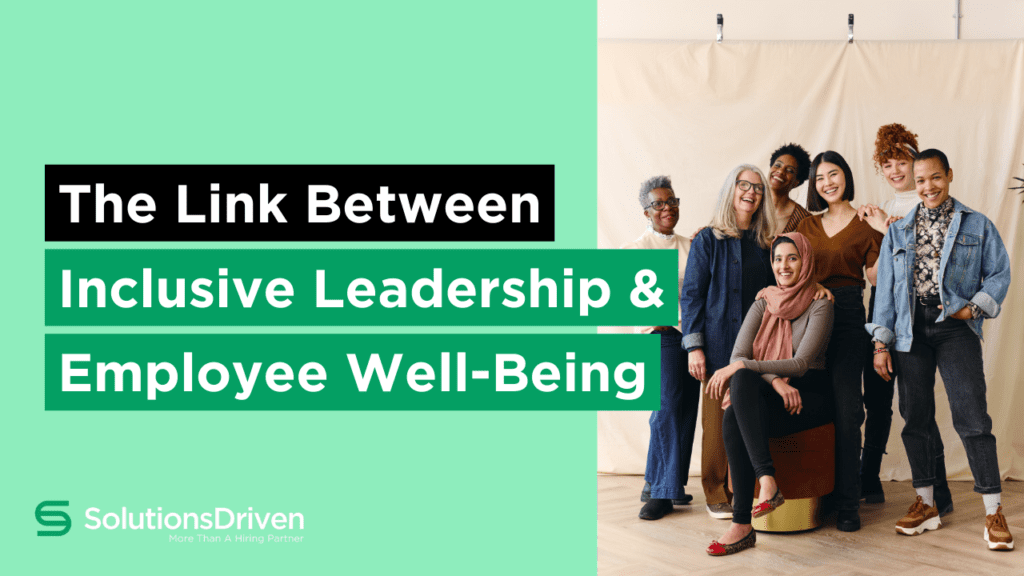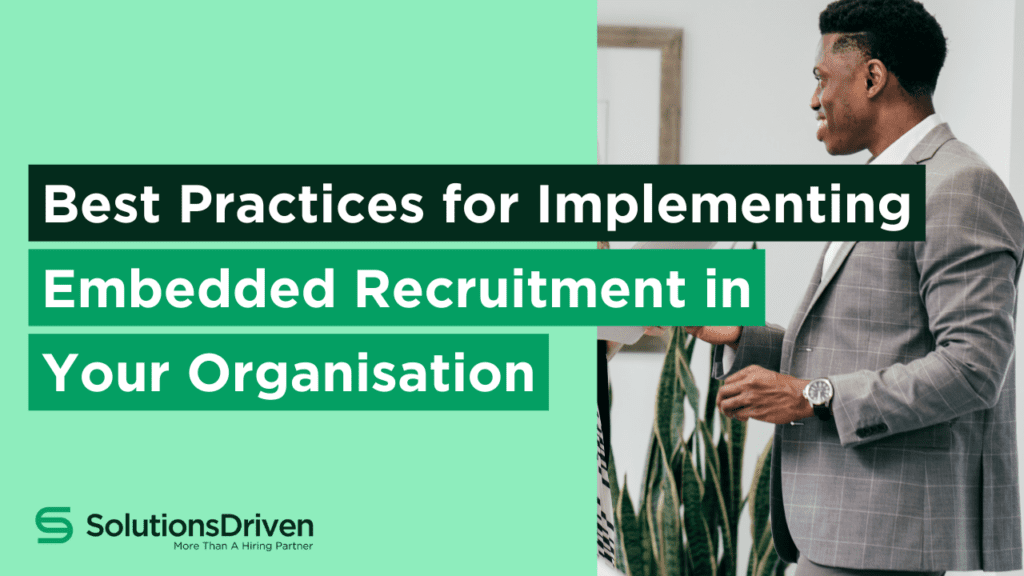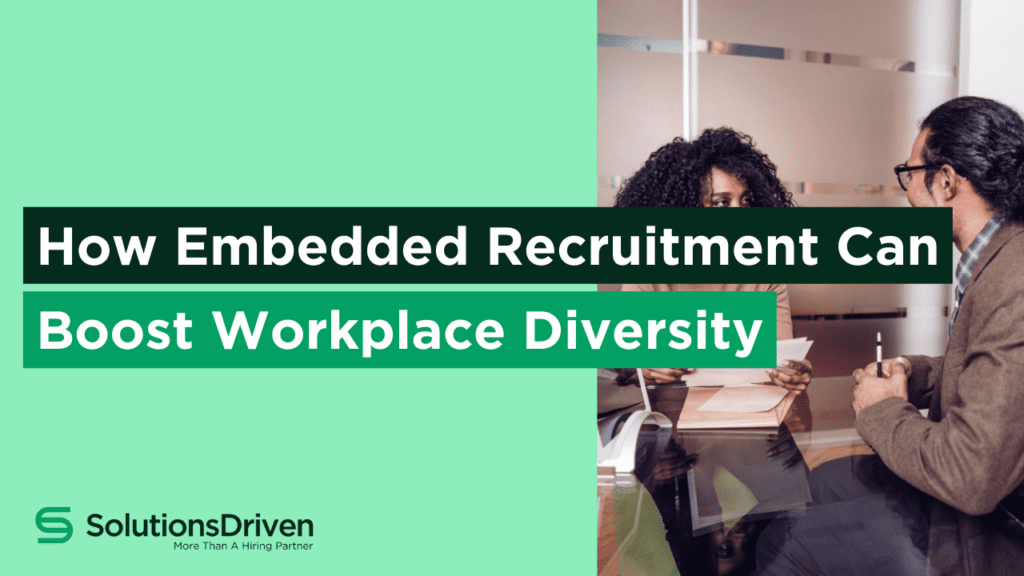To be the first to hear about our latest blogs, whitepaper releases, hiring enablement podcast episodes and get exclusive event invites, join our Exclusive Hiring Enablement Community.
We’ve been talking a lot about inclusive leadership recently. Why? Well, it’s an approach that embraces diversity and equal opportunity and has become a hugely powerful tool for modern businesses. If you haven’t done so already, check out our recent white paper on Inclusive Leadership: The Secret to DE&I Success.
Employee well-being, on the other hand, is the holistic health status of an employee, and covers physical, mental, emotional, and social aspects.
Both concepts are crucial, of course, but realising the power of their connection can be transformative for your organisation. Want to know more? Let’s dive in and explore the link between inclusive leadership and employee well-being.
Understanding inclusive leadership
Inclusive leadership refers to leaders who create an environment where all team members feel valued, respected, and treated fairly. Key characteristics of inclusive leaders include empathy, humility, and cultural intelligence.
Accenture is a great example of an organisation that’s been recognised multiple times for its commitment to inclusive leadership. The company has a clear diversity and inclusion strategy, which is integrated into every aspect of its business, including recruitment, development, retention, and advancement of employees. Accenture’s leaders are expected to create an inclusive environment where everyone feels valued, respected, and engaged. And they encourage open dialogue, provide equal opportunities for growth, and celebrate the unique contributions of every employee. The result? Accenture has seen increased innovation, improved decision-making, and higher levels of employee satisfaction and engagement.
And then Microsoft is a further example. The tech giant has made substantial efforts to build an inclusive culture and has a high-level exec overseeing diversity and inclusion initiatives. Microsoft’s CEO, Satya Nadella, has been vocal about his commitment to creating an inclusive environment. He encourages leaders within the company to be empathetic, open-minded, and respectful of different perspectives. This approach has not only helped Microsoft attract and retain diverse talent but also to encourage innovation and improve their overall performance.
It’s examples like these that illustrate the power of inclusive leadership. It’s not just about the right policies or strategies; it’s about creating a culture where everyone feels valued and can contribute to their fullest potential.
Employee well-being: a holistic approach
Employee well-being’s a complex concept that goes beyond just physical health. It includes mental, emotional, and social health too. It’s about how employees feel about their work environment, their job, working relationships, and work-life balance. Employee well-being isn’t just the absence of negative factors like stress or illness, but also the presence of positive ones that result in productivity, satisfaction, and personal growth.
All these different components of employee well-being are interrelated and equally important. Physical well-being involves the employee’s overall health – think nutrition, exercise, sleep, and the absence of illness or injury. And mental well-being refers to the employee’s psychological state – stress levels, cognitive function, and overall mental health. Emotional well-being involves feelings and attitudes towards work (and life in general), and includes self-esteem, resilience, and emotional intelligence. And lastly, social well-being relates to the quality of relationships and interactions with colleagues and others in the workplace.
The impact of employee well-being on performance and satisfaction is immense. According to research by Gallup, employee burnout costs businesses 15-20% of their total payroll annually. But when employees are physically healthy, they’re much less likely to take sick leave and more likely to be energetic and productive. Great mental health allows employees to think clearly, make sound decisions, and cope with work-related stress. Positive emotional well-being can lead to higher levels of job satisfaction, motivation, and commitment. And social well-being will lead to teamwork, collaboration, and a sense of belonging in the workplace.
The benefits of inclusive leadership and employee well-being
Did you know that inclusive leadership is not only your secret weapon to DE&I success? It will positively influence employee well-being too.
Inclusive leadership and employee well-being are intrinsically connected, with one often influencing the other. Inclusive leaders who value diversity and create an environment where all employees feel valued can significantly impact their workforces’ well-being.
You see, an inclusive leader treats all employees fairly, respects their unique perspectives, and values their contributions, regardless of their background or identity. And it’s this approach that creates a positive working culture where everyone feels accepted and appreciated for who they are. This results in better emotional well-being, which leads to higher job satisfaction and commitment.
But the benefits don’t end there. Inclusive leadership can create feelings of belonging and psychological safety among employees. And this sense safety can boost employees’ mental well-being by reducing stress and anxiety, not to mention enhance positive relationships with colleagues and even clients. A knock-on effect of great customer relations is an improved reputation and positive online reviews.
And let’s not forget the importance of communication and feedback in inclusive leadership. Inclusive leaders communicate openly and transparently with their teams, ensuring that everyone is informed and involved. They also provide constructive feedback and encourage their employees to do the same. The advantage? Employees can voice their concerns, share their ideas, and feel heard, all of which will contribute positively to their emotional and mental well-being.
Ultimately, inclusive leadership isn’t just about promoting diversity. It’s about enhancing employees’ well-being and, in turn, driving an organisation’s success.
Real-world examples
Want the inside info on companies successfully implementing inclusive leadership initiatives and impacting well-being? Here are just a couple of famous examples…
McDonald’s has publicly shared its support for workplace inclusion. The global fast-food chain has created an environment where every employee, regardless of their background, can thrive. And McDonald’s leaders continually work to improve diversity and inclusion, recognising that it contributes significantly to the company’s success.
A McDonald’s employee mentioned how the company’s inclusive policies provided them with opportunities for growth and development, enhancing their sense of belonging and job satisfaction.
Deloitte’s another global organisation and it approaches inclusive leadership as a skill that can be developed. The company’s put mechanisms in place to ensure diverse candidate pools when recruiting and has embedded inclusion efforts into performance metrics.
A Deloitte employee stated that the company’s commitment to diversity and inclusion made them feel valued and appreciated, contributing to a positive work environment and their overall job satisfaction.
What can we learn from these examples?
These examples highlight a few best practices. Firstly, inclusive leadership requires visible commitment. Leaders must not only talk about diversity and inclusion but also take concrete actions to improve them.
Secondly, it’s important to embed inclusion efforts into the company’s structures and processes. This could involve ensuring diversity in recruitment, incorporating diversity and inclusion metrics into performance evaluations, or providing training to managers on inclusive leadership.
Lastly, inclusive leaders need to show compassion and understand that employees may be affected differently by various situations. This understanding can help leaders create an environment where all employees feel supported and valued, contributing to their overall well-being.
Challenges and solutions
Implementing inclusive leadership for well-being can come with challenges. And one of the most common is resistance to change. Some team members may feel uncomfortable with the shifts in dynamics that inclusive leadership can cause, leading to pushback or reluctance to participate.
Then there’s unconscious bias which can hinder the recognition and inclusion of diverse perspectives. This can create barriers when working towards a truly inclusive environment.
And additionally, there’s the challenge of ensuring equal participation, as some voices may naturally dominate, while others may feel hesitant to speak up.
So how can you overcome these barriers?
The answer lies in strategic planning and conscious effort. As a leader you can address resistance to change by encouraging open discussions about the benefits of inclusion with the aim of gaining buy-in from all team members. To combat unconscious bias, consider providing training sessions to raise awareness and offer tools to minimise its impact.
And make sure you’re creating safe spaces for dialogue and encouraging all members to share their thoughts to help ensure equal participation. Overall, it’s important to establish a culture of respect where everyone’s ideas are valued, creating an environment where individuals feel comfortable expressing their views.
Practical tips for leaders
Are you ready to improve your inclusive leadership skills? It takes dedication, but you’ll reap the rewards…
Firstly, take time out for your own self-reflection, education, and training. Then commit more time to continuously assess the effectiveness of your strategies – be prepared to adjust them as teams evolve and new challenges arise. This might mean seeking regular feedback from your team, monitoring participation levels in discussions, or tracking progress towards diversity and inclusion goals.
Crucially, be aware that inclusive leadership isn’t a one-time initiative but a continuous process that requires your ongoing commitment and adaptability.
Measuring success
How do you know your inclusive leadership initiatives are impacting well-being? The key is monitoring and measuring. Here’s how:
1. Set KPIs
Using various Key Performance Indicators (KPIs) will provide you with useful insight. You might include diversity metrics, such as the representation of different groups within your organisation or a team. Or employee engagement levels which will give you an indication of how well employees feel they’re being heard and valued.
Also measure retention rates for insight into job satisfaction and wellbeing. High retention rates probably suggest that employees feel valued and included.
2. Use feedback and surveys
Regularly asking for feedback from employees can provide valuable insights into how well your inclusive leadership strategy is working. Surveys can be used to gauge employees’ perceptions of inclusivity, their sense of belonging, and their overall happiness. Try including open-ended questions to gather qualitative data and provide deeper insights into employees’ experiences. It’s important to ensure anonymity in these surveys to encourage honest responses.
3. Monitor and adjust strategies based on results
Once you’ve got your data it’s crucial to not just analyse the results but adjust your strategies accordingly. If the KPIs indicate that certain aspects of the inclusive leadership approach aren’t working as intended, change them! Do your results suggest some employees don’t feel heard? Consider new strategies to encourage participation and open dialogue. This kind of continuous monitoring and adjusting is vital to the successful implementation of inclusive leadership and its positive impact on well-being.
The link between inclusive leadership and employee well-being is clear: when leaders create an inclusive environment, employees thrive. And when employees thrive, so too do businesses.
Are you prioritising inclusive leadership as a way of enhancing employee well-being? If not, there’s never been a better time to start – it’s key in driving organisational success! If you want to know more about inclusive leadership and it’s many benefits, download our white paper: Inclusive Leadership: The Key to DE&I Success. Or get in touch to learn more about how we’re helping companies like yours to unlock the power of diversity and inclusion.







